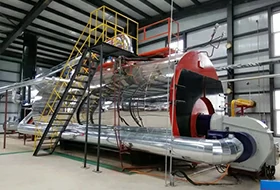
9월 . 08, 2024 09:55 Back to list
Oil Fired Hot Water Boiler - Efficient Heating Solutions
Understanding the Oil-Fired Hot Water Boiler Diagram
An oil-fired hot water boiler is a crucial component in many heating systems, providing an efficient means of producing hot water for residential and commercial applications
. Understanding the diagram of an oil-fired hot water boiler can greatly enhance our comprehension of its operation, components, and maintenance requirements.At the heart of the oil-fired hot water boiler is the combustion chamber, where heating oil is burned to produce heat. This chamber is connected to an oil tank that stores the fuel and sends it through a network of pipes to the burner. The burner atomizes the oil, mixing it with air to achieve complete combustion, thereby maximizing efficiency. This combustion process results in hot gases that pass through a heat exchanger.
The heat exchanger is a critical element in the system. It transfers heat from the hot combustion gases to water circulating through the boiler. The water is heated as it flows through the heat exchanger, which significantly increases its temperature and prepares it for distribution throughout the building.
oil fired hot water boiler diagram

Once the water is heated, it moves into the distribution system, typically consisting of pipes that carry hot water to radiators, underfloor heating systems, or domestic hot water storage tanks. This distribution network enables efficient heat transfer, ensuring that various parts of the building receive the necessary warmth.
The diagram also highlights several auxiliary components essential for the safe and reliable operation of the boiler. These include safety valves, which prevent overpressure, and expansion tanks that accommodate changes in water volume as it heats and cools. Additionally, thermostats control the operation of the burner, maintaining a comfortable temperature by regulating when the boiler should turn on or off.
Maintenance is vital for ensuring the longevity and efficiency of an oil-fired hot water boiler. Regular inspections, cleaning of the burners, and checking for leaks in the fuel supply lines are recommended practices. By understanding how each part of the boiler system functions, homeowners and facility managers can recognize signs of potential issues and address them promptly.
In conclusion, the oil-fired hot water boiler diagram is a valuable tool for anyone looking to understand its operations. By familiarizing oneself with the critical components and their interactions, users can optimize performance, ensuring a reliable and efficient hot water supply throughout their properties. Understanding this system is not only essential for effective operation but also for ensuring energy efficiency and reducing heating costs.
-
Efficient Biomass Fired Hot Water Boiler | AI Heating Solution
NewsAug.01,2025
-
High-Efficiency Gas Thermal Oil Boilers | HPT Models
NewsJul.31,2025
-
Oil Fired Hot Water Boilers Sale - High Efficiency & Affordable
NewsJul.31,2025
-
High-Efficiency Commercial Oil Fired Steam Boiler for Industry
NewsJul.30,2025
-
High-Efficiency Biomass Fired Thermal Oil Boiler Solutions
NewsJul.30,2025
-
High Efficiency Gas Fired Thermal Oil Boiler for Industrial Heating
NewsJul.29,2025
Related PRODUCTS






















